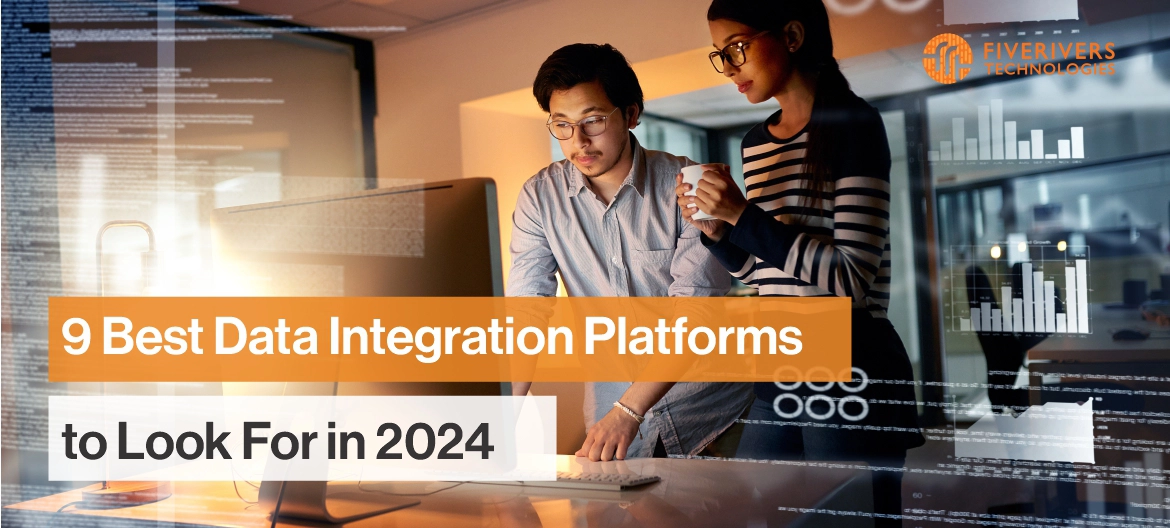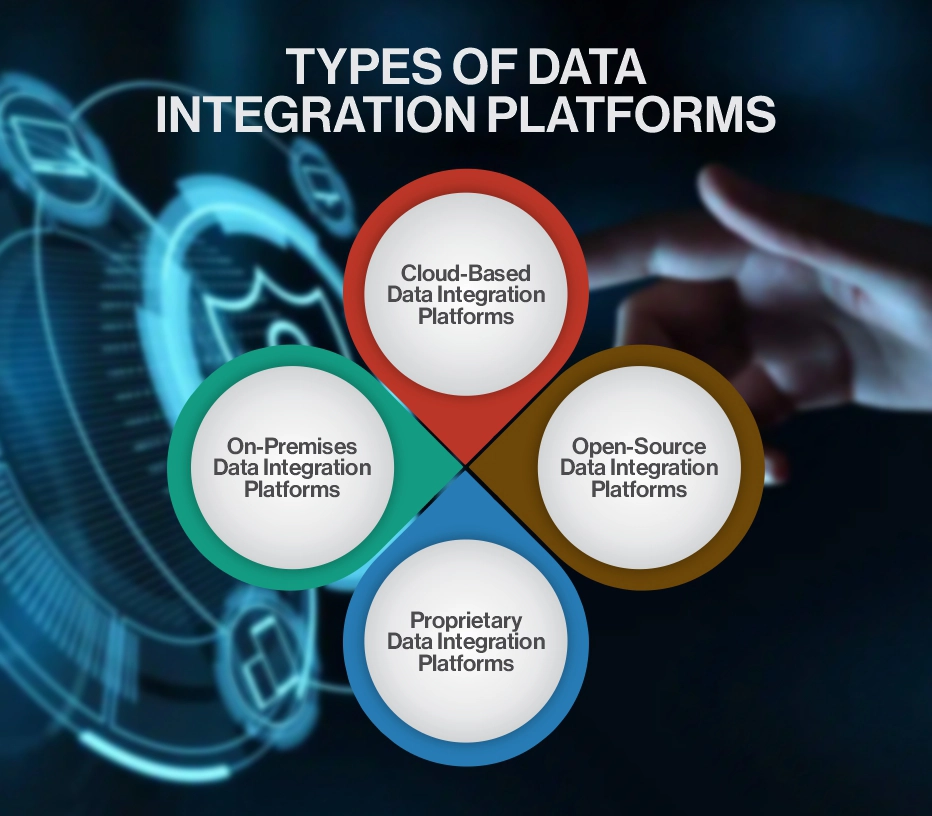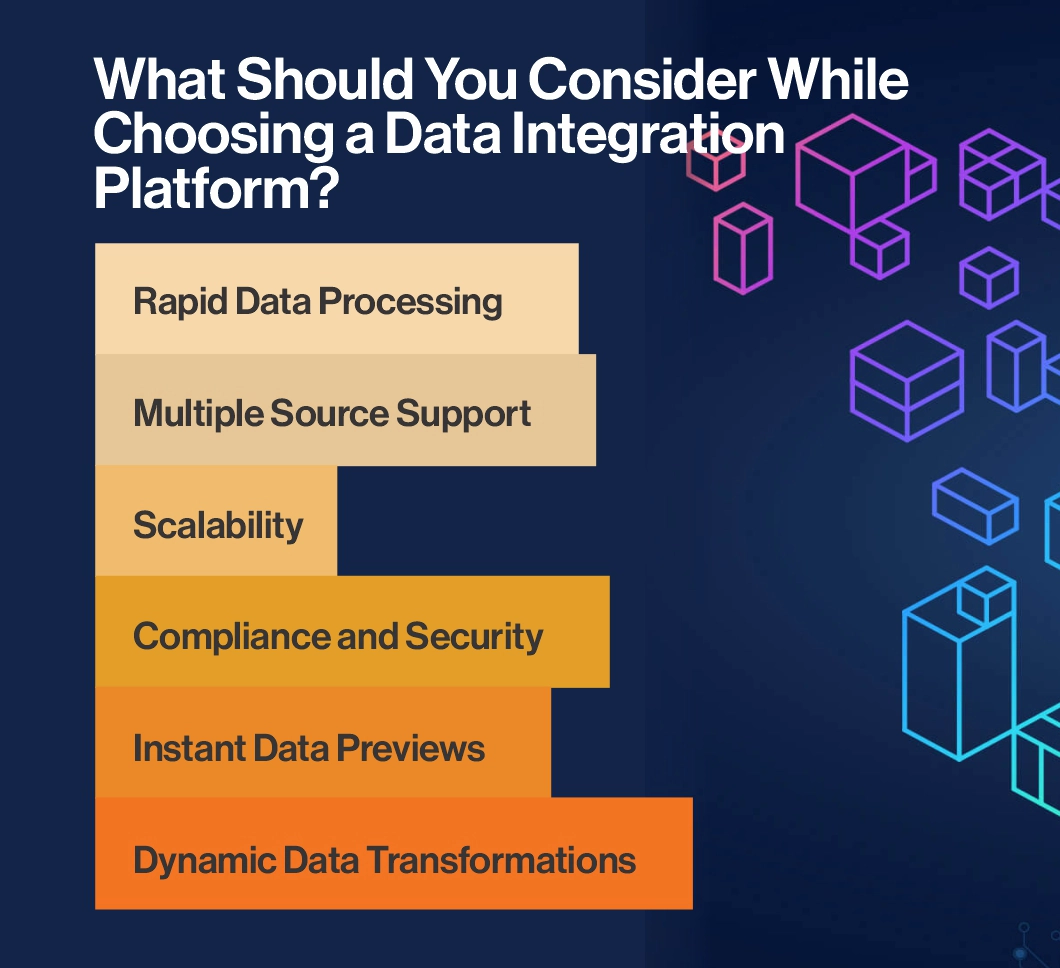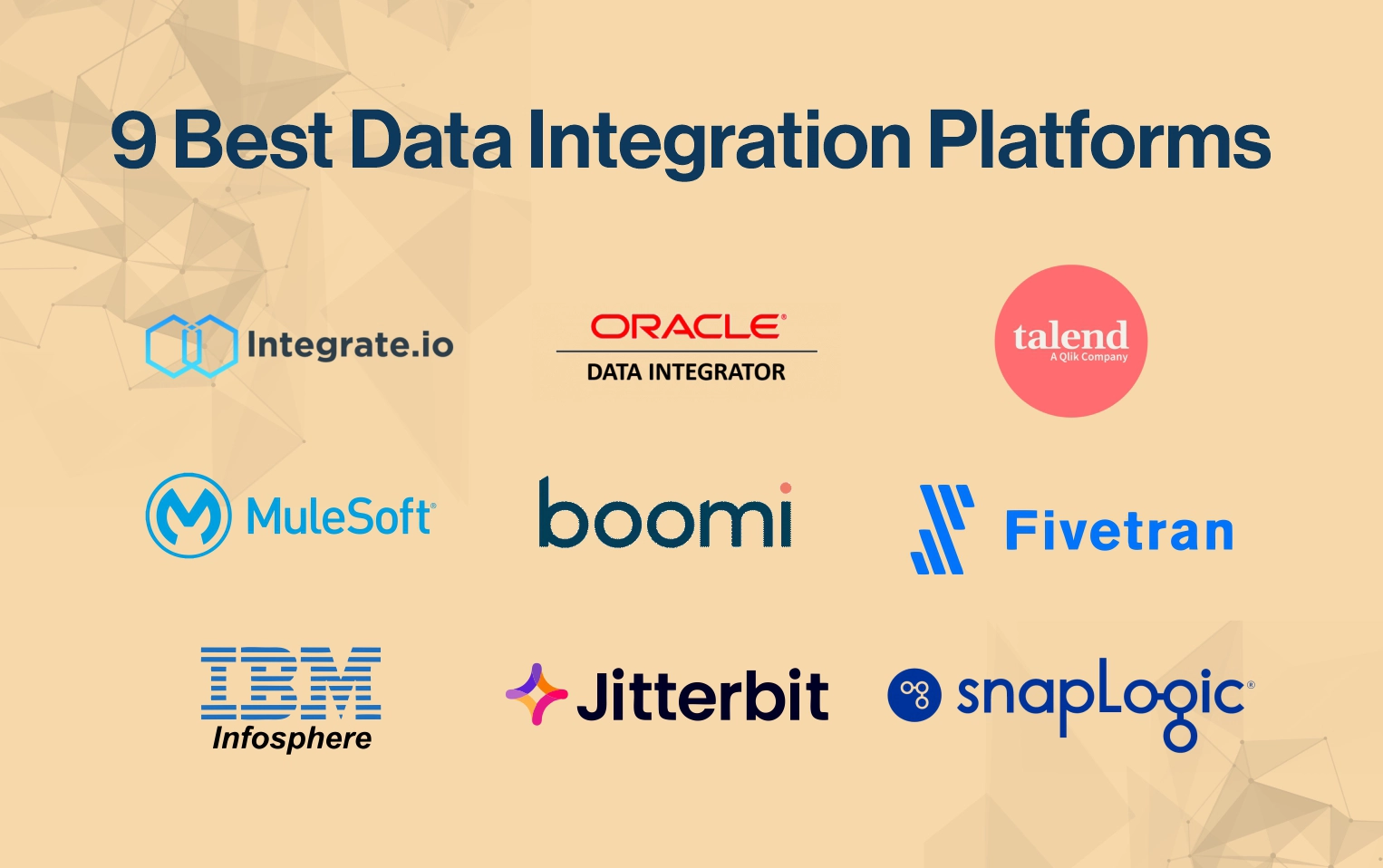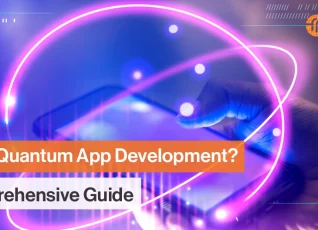Data integration is like bringing together puzzle pieces into one big picture. Tools called Data Integration Platforms help with this, making data easier to use for analysis and reporting. They collect data from many sources, tidy it up, and keep it organized in one central area.
Businesses rely on integrated data for decision-making and analysis, but it can be tricky when dealing with data from many sources.
ETL tools and other technologies like data integration platforms help simplify the process by automating data collection, cleaning, and transformation from various sources.
7 Use Cases of AI in Data Analytics
In this article, we’ll discuss the mechanics of data integration while presenting a comprehensive overview of the top 9 data integration platforms in 2024. So, let’s get started!
Key Takeaways:
- Data integration platforms streamline data collection, cleaning, and storage from diverse sources into one central location
- They enable businesses to make informed decisions and conduct analysis effectively by integrating data
- Data integration platforms include ETL (Extract, Transform, Load) and ELT (Extract, Load, Transform) tools
- Key features to consider in a data integration platform include rapid data processing, multiple source support, scalability, compliance, and security
- Cloud-based, on-premises, open-source, and proprietary are the main types of data integration platforms
- Top data integration platforms in 2024 include Integrate.io, Oracle Data Integrator, Talend Cloud Data Integration, MuleSoft, Dell Boomi, Fivetran, IBM InfoSphere, Jitterbit, and SnapLogic
- Benefits of data integration platforms include improved data accuracy, operational efficiency, decision-making, security, and cost reduction
What is Data Integration?
Merging data from several sources into a single, cohesive system is known as data integration. Businesses need data to make smart choices. But these data are frequently dispersed over multiple places. Data integration solves this puzzle by gathering all your data into one easy-to-find spot.
Consider it as a recipe with several stages. You start by gathering components, or data, from various sources. Then, you mix and cook them (transforming and loading) into a new dish (system).
Data Integration from Past to Present
Data integration began in the 1980s with the rise of data warehousing. Back then, organizations realized the importance of bringing data from different places together into one central location for analysis and reporting. This era mainly focused on batch processing, where data was collected, cleaned, and loaded into warehouses at set times.
Over time, data integration advanced to handle real-time processing, allowing access to and analysis of data as it’s produced. Technologies like middleware, data federation, and cloud computing have expanded the possibilities of data integration, making it even more powerful and flexible.
What is a Data Integration Platform?
One technology that aids in gathering data from several sources and storing it in one central location, like a data warehouse, is a data integration platform. Centralized storage makes it easier for analysts and data scientists to analyze the data and gain insights to improve business operations.
Extract, Transform, Load (ETL) and Extract, Load, Transform (ELT) are two popular techniques for data integration.
- Extraction entails gathering data from many sources, including spreadsheets, sensors, apps, and outside software. The integration procedure gets more complicated the more sources you have
- Loading is when collected data is sent to a target such as storage system (like a data lake or warehouse).
- Transformation is the process of preparing data for analysis by standardizing, cleansing, and structuring it. Transformations take place throughout the ETL process prior to the data being loaded into storage. The ELT approach loads data into storage first, with analysts applying transformations as needed
With the right data integration solution, companies can make their analytics better, work together more easily, get rid of data silos, and use automation to make things run smoother.
Types of Data Integration Platforms
To create a smooth data flow, businesses can use a variety of data integration solutions.
Platforms for data integration fall into four categories:
Cloud-Based Data Integration Platforms
These solutions connect data to storage located in the cloud, including cloud data warehouses. Scalability, flexibility, and cost reductions may be achieved more easily when using a cloud platform.
On-Premises Data Integration Platforms
These tools employ connections to collect data from various local sources, such various internal business teams, and are placed on a local network or private cloud.
Open-Source Data Integration Platforms
These tools have publicly available source code that developers can modify. They are often free and allow developers to manually build custom data pipelines according to their requirements.
Proprietary Data Integration Platforms
Third-party providers develop and manage these tools. Businesses can select from various pricing models to suit their data integration needs.
What Should You Consider While Choosing a Data Integration Platform?
When selecting a data integration platform, organizations must carefully consider several key factors to meet their specific goals and requirements.
Here are essential features to look for in an effective data integration platform:
Rapid Data Processing
A reliable platform should support fast data processing, enabling swift analysis and insights. Quick access to data-backed suggestions can drive competitive advantages by facilitating prompt decision-making across business departments.
Multiple Source Support
Select a platform that effectively collects information from several sources, such as SaaS apps, databases, and other corporate systems. Limitations on source types or numbers can hinder data extraction and analysis.
Scalability
Choose a cloud-based integration platform to facilitate easy scalability. Platforms like Fivetran offer flexible subscription models, allowing you to scale resources as needed and ensuring seamless growth and adaptation to changing demands.
Compliance and Security
Security and compliance are paramount in data handling to prevent costly data breaches and maintain customer trust. Look for platforms with robust privacy, security, and compliance measures, including encryption, access controls, and detailed logging.
Instant Data Previews
Real-time analysis requires instant data availability. Platforms that support real-time data ingestion and previews empower analysts to access and analyze new data, accelerating insights generation quickly.
Dynamic Data Transformations
For efficient ELT workflows, choose a platform with pre-built transformations that can immediately process data upon loading. This capability shortens the time needed to obtain meaningful insights by streamlining data transformation procedures.
9 Best Data Integration Platforms
Now, have a look at the top 9 data integration platforms you need to look for in 2024:
Integrate.io
Integrate.io is like a handy wizard that helps you manage your data effortlessly. It stands for Extract, Transform, Load, which means it pulls data from different places, tweaks it to be more useful, and then sends it where it needs to go. Moreover, it doesn’t require you to be an expert coder to use it.
With Integrate.io, you get this cool tool to design your data journey visually. It is like plotting lines on a map to indicate your data’s locations. This makes it very simple and hassle-free for any member of your team to obtain the data they want.
All the messy stuff, like cleaning up data and ensuring it’s in the right format, happens right there on the platform. It’s like having a magical cleaning crew for your data!
The best thing? You can use Integrate.io wherever you want, whether in the cloud, on your own servers, or even on the Internet. Setting it up is a breeze; you don’t have to worry about tinkering with complicated settings or keeping everything up to date—it’s all taken care of for you!
Also, the interface is so easy to use that even non-tech people can create powerful data pipelines. It’s like having a super-smart assistant guiding you every step of the way.
Oracle Data Integrator
Oracle Corporation produces the enhanced data integration tool known as Oracle Data Integrator (ODI). Its main job is to help companies integrate data from systems, apps, and databases.
This tool is strong and can do many things to improve data, like making sure it’s all consistent and automating how it’s assembled.
What’s cool about ODI is that it has a visual workflow. Instead of typing out a bunch of code, you can drag and drop things on a screen to build your data flows. It’s like playing with building blocks!
You can do all sorts of fancy stuff with ODI, like connecting to different data sources and making your data look the way you want using SQL or other programming languages. And it’s safe, too, with top-notch security features keeping your data locked up tight.
Overall, ODI is like having a smart assistant for your data work. It can handle a lot of data and is simple to use.
Talend Cloud Data Integration
Talend Cloud Data Integration is like a bridge connecting different data types, whether in the cloud or on your own servers. Whether or whether someone in your company is computer savvy, it’s made to be incredibly simple to use.
Talend’s intuitive UI and practical features make it simple to integrate all your data. Think of it as a toolbox filled with all the tools you need to handle data, from simple tasks to complex ones.
It’s not just about gathering data, though. Talend also helps you clean it up and ensure its top-notch quality. This means you don’t waste time dealing with messy data that could lead you astray.
When you’ve set up your data pipelines, Talend lets you run them in different applications, like Spark, to ensure smooth operation. Its built-in inventory feature lets you keep track of all your data and easily move it to different storage places.
If you need more advanced features, Talend has them for you. You can expand its capabilities with other Talend Cloud applications while staying within the same easy-to-use software suite.
MuleSoft
MuleSoft is like a super connector for all your digital stuff, whether apps, data, or gadgets, no matter where they hang out, whether in your office or the cloud. Their Anypoint Platform helps you whip up, throw out, and manage all these connections in a snap.
MuleSoft’s flexibility is among its finest features. It’s like a shapeshifter that can handle all sorts of connections, from stuff that happens right away to things that take their sweet time. It’s also a whiz at turning data into whatever shape you need and understands all kinds of data talk.
MuleSoft doesn’t just stop at making connections; it’s got your back with managing APIs, keeping an eye on what’s happening, and keeping everything locked up tight. And if you ever get stuck, thanks to its bustling community, there’s a bunch of folks ready to help.
Dell Boomi
Dell Boomi is like a cloud-native superhero for blending data seamlessly across different cloud setups, making life easier for businesses drowning in organizational silos. Its easy-to-use interface, backed by clever suggestions, offers a smooth ride for data integration from start to finish. By swiftly bringing your data and apps together, Dell Boomi turbocharges your business agility, letting you stay nimble in the face of market shifts and new ideas.
With Dell Boomi, you can improve the quality of your data, give it a makeover, and even modernize older apps. It comes with a whopping 1,500 ready-to-go connections, automating many common integrations and saving you time tinkering with custom setups. Plus, it’s packed with goodies like API management, sniffing out data, and keeping your data quality shipshape.
Fivetran
Fivetran is like having a cloud-based magic wand to connect all your data dots. With it, you can effortlessly link up your data sources and destinations, skipping the headache of manual data transfers.
The real charm of Fivetran lies in its automation powers. Once everything is set up, it works its magic, automatically spotting changes in your data sources and updating your destination almost instantly.
Easy to use and super-efficient, Fivetran is your go-to platform for simplifying data pipelines and boosting data-driven decision-making. Whether you’re a small business or a bigwig enterprise, Fivetran’s got your back, ensuring your data is always fresh and up to speed.
IBM InfoSphere
IBM InfoSphere is the best for data integration, offering a toolbox full of tools and tech to weave your data into a cohesive tapestry across different systems and apps.
It’s like a data maestro, helping you create a harmonious symphony from disparate sources, bringing them together for a unified view.
With InfoSphere, you can effortlessly blend data from all sorts of places – databases, files, apps; and whip it into shape for analysis and reporting.
But it doesn’t stop there. InfoSphere also has tools to monitor your data, ensuring its quality, governance, and metadata are ready for accurate and consistent data journeys.
Jitterbit
Jitterbit connects different applications in the cloud, on your own servers, or as software-as-a-service (SaaS). It’s not just about connecting apps; Jitterbit lets you sprinkle in some Artificial Intelligence magic to jazz up your applications and create brand-new solutions.
Creating new connections or tapping into existing ones is a breeze with Jitterbit. They are prepared with an abundance of pre-made templates and processes. And if you need something more bespoke, their point-and-click interface lets you craft your own integrations and templates without breaking a sweat. Also, sharing your custom creations with colleagues is a snap, making teamwork a cinch.
Jitterbit, has you covered whether your apps are in the cloud, on-premises, or anywhere in between. Whether you need to process data in real-time or in batches, Jitterbit can handle it all, ensuring your operations run smoothly, no matter the task.
SnapLogic
SnapLogic is a robust data integration platform offering self-service digital transformation tools. Its specialty is bringing together data from all corners of the digital universe.
One standout feature? It’s got a knack for talking to the Internet of Things devices, unlocking a treasure trove of valuable insights.
SnapLogic has a laundry list of features: it makes complex integrations a breeze, automates business tasks, orchestrates data flows, supports easy integration with minimal coding, boasts a whopping 500 pre-built connectors, and even offers AI-powered suggestions to make your integration journey smoother than silk.
Benefits of Data Integration Platforms
Data Integration Platforms offer many benefits to organizations:
- They improve data accuracy and consistency.
- They increase operational efficiency.
- They enable better decision-making.
- They enhance security and privacy.
- They reduce costs.
These platforms’ graphical user interfaces and ease of use make data management smoother. They handle errors well and can manage complex data effectively. They support businesses in growing profitably and utilizing their data to the fullest.
Conclusion
If you’re a business owner, chances are you rely on various platforms and tools to keep your business running smoothly. However, managing the data generated from these sources can be overwhelming. Manually consolidating and making sense of all this data requires significant resources and often leaves room for error.
That’s where data integration comes in. Using data integration platforms, you can streamline the consolidation and management of your data. When choosing a data integration platform, looking for one with good ratings and reviews online, easy setup and usability, responsive customer service, and affordability is important.
If you want to effectively leverage the benefits of a data integration platform, you can reach out to FiveRivers Technologies, the best software development company with over 500+ custom software solutions delivered.
FAQs
What is an Example of Data Integration?
An example of data integration is a retail company combining data from its sales, inventory, and customer databases to generate comprehensive reports on product performance, identify trends, and optimize supply chain management.
What Are the Four Types of Data Methodologies?
- Application-based Data Integration
- Data Virtualization
- Middleware Data Integration
- Change Data Capture (CDC)



